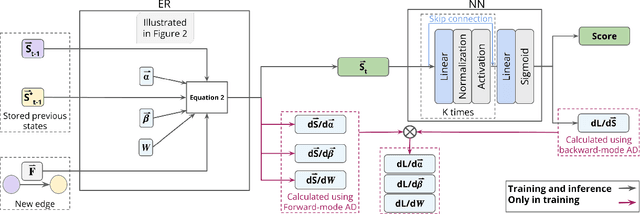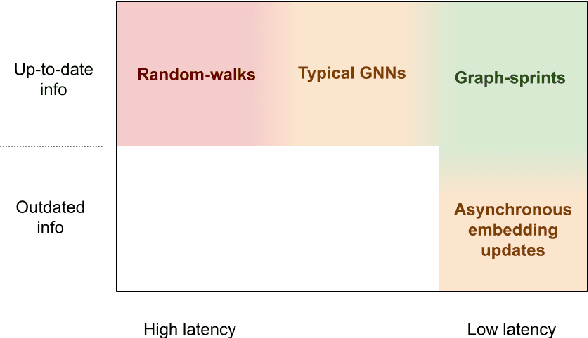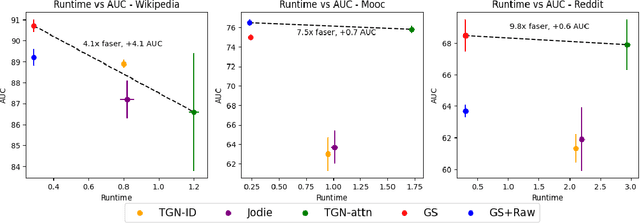Ahmad Naser Eddin
Deep-Graph-Sprints: Accelerated Representation Learning in Continuous-Time Dynamic Graphs
Jul 10, 2024



Abstract:Continuous-time dynamic graphs (CTDGs) are essential for modeling interconnected, evolving systems. Traditional methods for extracting knowledge from these graphs often depend on feature engineering or deep learning. Feature engineering is limited by the manual and time-intensive nature of crafting features, while deep learning approaches suffer from high inference latency, making them impractical for real-time applications. This paper introduces Deep-Graph-Sprints (DGS), a novel deep learning architecture designed for efficient representation learning on CTDGs with low-latency inference requirements. We benchmark DGS against state-of-the-art feature engineering and graph neural network methods using five diverse datasets. The results indicate that DGS achieves competitive performance while improving inference speed up to 12x compared to other deep learning approaches on our tested benchmarks. Our method effectively bridges the gap between deep representation learning and low-latency application requirements for CTDGs.
From random-walks to graph-sprints: a low-latency node embedding framework on continuous-time dynamic graphs
Jul 18, 2023



Abstract:Many real-world datasets have an underlying dynamic graph structure, where entities and their interactions evolve over time. Machine learning models should consider these dynamics in order to harness their full potential in downstream tasks. Previous approaches for graph representation learning have focused on either sampling k-hop neighborhoods, akin to breadth-first search, or random walks, akin to depth-first search. However, these methods are computationally expensive and unsuitable for real-time, low-latency inference on dynamic graphs. To overcome these limitations, we propose graph-sprints a general purpose feature extraction framework for continuous-time-dynamic-graphs (CTDGs) that has low latency and is competitive with state-of-the-art, higher latency models. To achieve this, a streaming, low latency approximation to the random-walk based features is proposed. In our framework, time-aware node embeddings summarizing multi-hop information are computed using only single-hop operations on the incoming edges. We evaluate our proposed approach on three open-source datasets and two in-house datasets, and compare with three state-of-the-art algorithms (TGN-attn, TGN-ID, Jodie). We demonstrate that our graph-sprints features, combined with a machine learning classifier, achieve competitive performance (outperforming all baselines for the node classification tasks in five datasets). Simultaneously, graph-sprints significantly reduce inference latencies, achieving close to an order of magnitude speed-up in our experimental setting.
Anti-Money Laundering Alert Optimization Using Machine Learning with Graphs
Dec 14, 2021



Abstract:Money laundering is a global problem that concerns legitimizing proceeds from serious felonies (1.7-4 trillion euros annually) such as drug dealing, human trafficking, or corruption. The anti-money laundering systems deployed by financial institutions typically comprise rules aligned with regulatory frameworks. Human investigators review the alerts and report suspicious cases. Such systems suffer from high false-positive rates, undermining their effectiveness and resulting in high operational costs. We propose a machine learning triage model, which complements the rule-based system and learns to predict the risk of an alert accurately. Our model uses both entity-centric engineered features and attributes characterizing inter-entity relations in the form of graph-based features. We leverage time windows to construct the dynamic graph, optimizing for time and space efficiency. We validate our model on a real-world banking dataset and show how the triage model can reduce the number of false positives by 80% while detecting over 90% of true positives. In this way, our model can significantly improve anti-money laundering operations.
 Add to Chrome
Add to Chrome Add to Firefox
Add to Firefox Add to Edge
Add to Edge